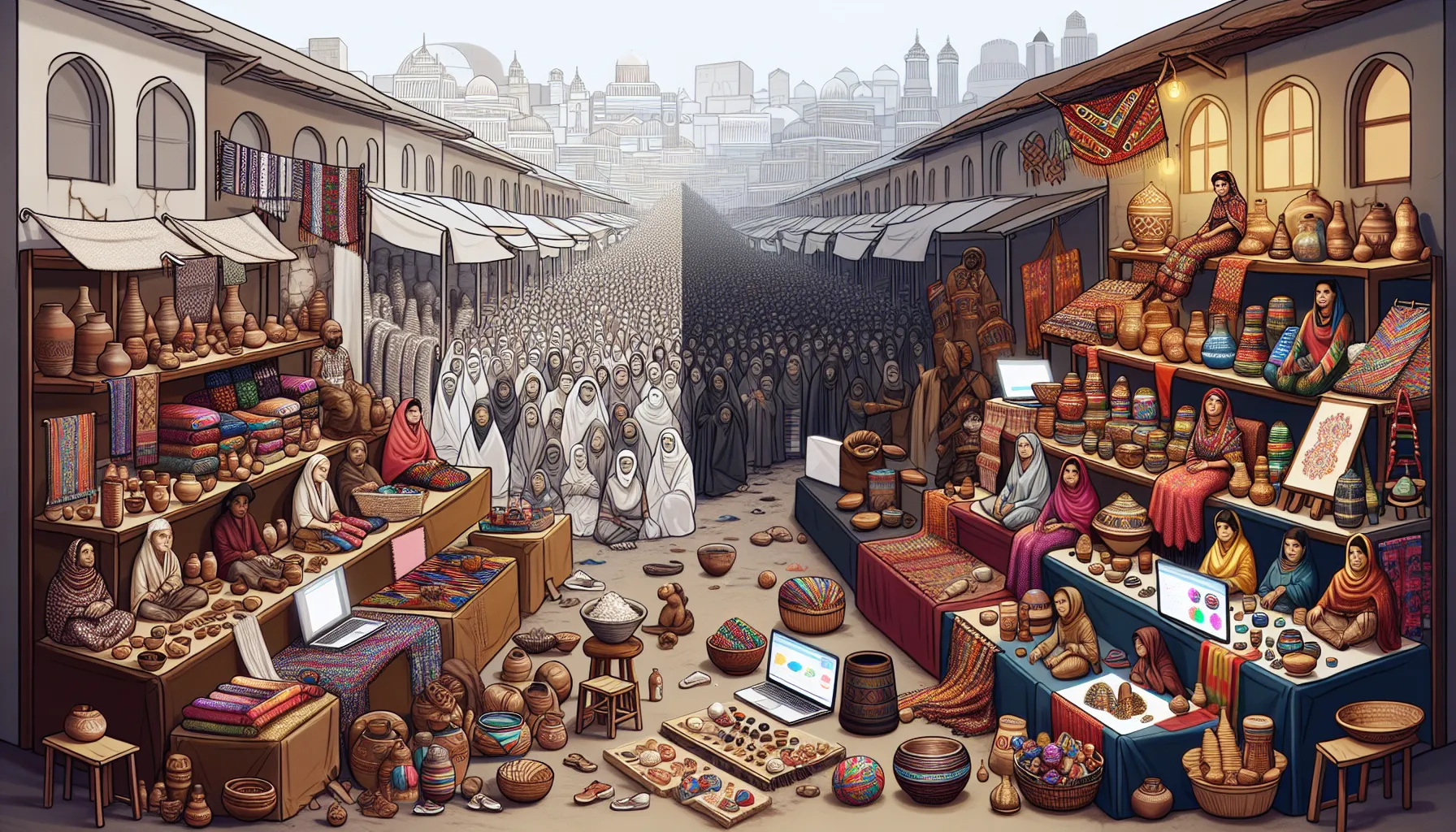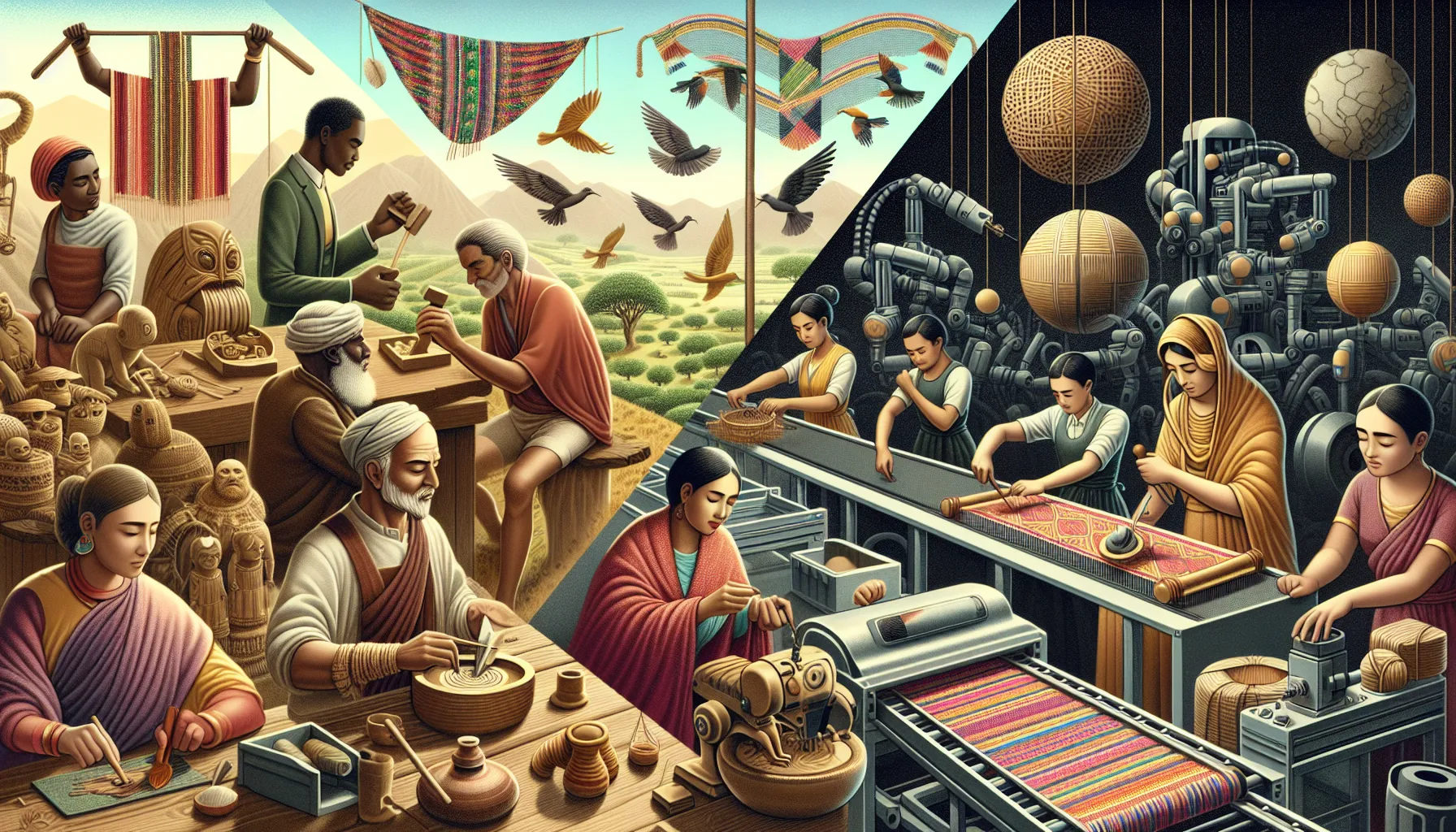The topic of globalization’s impact on local crafts and industries is a recurring theme in IELTS Writing Task 2. Based on past exam trends and the current global economic landscape, this subject is likely to appear frequently in future tests. Its relevance to contemporary issues makes it a popular choice for examiners seeking to assess candidates’ ability to analyze complex societal changes.
Nội dung bài viết
Let’s examine a typical question on this topic:
Some people think that globalization has negative effects on local and traditional crafts and industries. To what extent do you agree or disagree with this opinion?
Analyzing the Question
This question requires candidates to:
- Understand the concept of globalization and its effects on local economies
- Consider both positive and negative impacts on traditional crafts and industries
- Form a clear opinion and support it with relevant examples
- Structure the essay logically, addressing all parts of the question
Sample Essays
Band 8-9 Essay
Globalization, the process of increased interconnectedness and interdependence of world economies, has undoubtedly transformed local and traditional industries worldwide. While some argue that this phenomenon has solely negative consequences for these sectors, I believe that the reality is more nuanced, presenting both challenges and opportunities.
On one hand, globalization has indeed posed significant threats to local crafts and industries. The influx of mass-produced, often cheaper goods from international markets has made it difficult for local artisans and small-scale industries to compete. For instance, traditional textile makers in India have faced severe competition from machine-made fabrics imported from China, leading to a decline in their market share and, in some cases, the disappearance of age-old techniques. Similarly, local food producers often struggle to match the prices of globally sourced products, potentially leading to a homogenization of food cultures.
However, it would be shortsighted to view globalization purely as a destructive force. The interconnected global economy has also created new avenues for local crafts and industries to thrive. The internet and e-commerce platforms have enabled artisans to reach a global audience, showcasing their unique products to customers worldwide. For example, Peruvian alpaca wool garments, once limited to local markets, are now sought-after luxury items globally, thanks to online marketplaces. Moreover, the growing interest in sustainable and ethically produced goods has led to a resurgence in traditional craftsmanship, with consumers willing to pay premium prices for authentic, locally made products.
Furthermore, globalization has facilitated the exchange of ideas and techniques, potentially enriching local traditions rather than erasing them. Many local industries have adapted by incorporating modern technologies or design elements while maintaining their cultural essence. Japanese knife makers, for instance, have successfully blended traditional forging techniques with contemporary materials and designs, catering to both local and international markets.

In conclusion, while globalization undeniably presents challenges to local and traditional crafts and industries, its impact is not universally negative. The key lies in how local communities and policymakers respond to these changes. By embracing the opportunities offered by global connectivity while implementing measures to protect and promote local heritage, it is possible to ensure that traditional crafts and industries not only survive but thrive in the globalized world.
(Word count: 368)
Band 6-7 Essay
Globalization has become a significant topic in recent years, and its impact on local crafts and industries is often debated. While some people believe that globalization only brings negative effects to traditional sectors, I partially agree with this view as I think there are both advantages and disadvantages to consider.
On the negative side, globalization can indeed harm local crafts and industries in several ways. Firstly, the influx of cheap, mass-produced goods from other countries can make it difficult for local artisans to compete. For example, handmade textiles from small villages might be more expensive than machine-made clothes from big factories abroad, leading to a decrease in sales for local craftspeople. Secondly, as younger generations become more interested in modern, global trends, traditional crafts might lose their appeal and gradually disappear.
However, it’s important to note that globalization also brings opportunities for local and traditional industries. The internet and social media platforms allow small businesses to reach customers all over the world, potentially increasing their market and profits. For instance, a small pottery workshop in a rural area can now sell its unique products to collectors in other countries through online stores. Additionally, the growing interest in authentic and sustainable products among global consumers can benefit traditional crafts that often use natural materials and time-honored techniques.
Moreover, globalization can lead to the exchange of ideas and techniques between different cultures, which might actually enrich local traditions rather than destroy them. Local artisans can learn new methods or incorporate new designs while still maintaining the essence of their craft, making their products more appealing to a wider audience.
In conclusion, while globalization does pose challenges to local and traditional crafts and industries, it also offers new opportunities for growth and adaptation. The key is to find a balance between preserving cultural heritage and embracing the benefits of a connected world. Governments and communities should work together to support local industries in navigating these changes effectively.
(Word count: 309)
Band 5-6 Essay
Globalization is a big topic today and many people think it is bad for local crafts and industries. I partly agree with this idea because there are both good and bad things about globalization for traditional businesses.
One bad thing about globalization is that it can hurt small local businesses. Big companies from other countries can sell things cheaper, so people might not buy from local shops anymore. For example, a small furniture maker in a village might lose customers to a big international furniture store. Also, young people might prefer modern things from other countries instead of traditional crafts, so old skills could be lost.
But globalization is not all bad for local crafts. The internet helps small businesses sell their products to people all over the world. A person making traditional jewelry can now sell online to customers in different countries. Some people also like to buy special handmade things from other cultures, so this can help local craftspeople.
Globalization can also bring new ideas to local crafts. People can learn new ways to make things or use new designs, which can make their products more interesting. This can help local crafts stay popular.
In conclusion, globalization has both good and bad effects on local crafts and industries. It can make it hard for small businesses to compete, but it also gives them chances to sell to more people. I think it’s important to help local businesses use the good parts of globalization while keeping their traditions.
(Word count: 234)
Explanation of Band Scores
Band 8-9 Essay Explanation
This essay demonstrates excellent writing skills and a sophisticated approach to the topic, warranting a high band score:
- Task Response: The essay fully addresses all parts of the task, presenting a clear position with a balanced consideration of both negative and positive impacts.
- Coherence and Cohesion: Ideas are logically organized with clear progression throughout. Paragraphs are well-linked, and cohesive devices are used effectively.
- Lexical Resource: A wide range of vocabulary is used with very natural and sophisticated control of lexical features.
- Grammatical Range and Accuracy: A wide range of structures is used with full flexibility and accuracy.
Band 6-7 Essay Explanation
This essay shows good writing skills but lacks some of the sophistication of the higher band essay:
- Task Response: The essay addresses all parts of the task, presenting a clear position, though the ideas are less fully developed than in the band 8-9 essay.
- Coherence and Cohesion: There is a clear overall progression, but some paragraphs are better linked than others.
- Lexical Resource: A sufficient range of vocabulary is used appropriately, with some attempts at less common words.
- Grammatical Range and Accuracy: A mix of simple and complex sentence forms is used, with good control and only occasional errors.
Band 5-6 Essay Explanation
This essay demonstrates basic writing skills but lacks the depth and sophistication of higher band essays:
- Task Response: The essay addresses the task, but some points are underdeveloped.
- Coherence and Cohesion: There is a basic structure, but paragraphs are not always well-linked.
- Lexical Resource: The vocabulary is limited but generally adequate for the task.
- Grammatical Range and Accuracy: Mainly simple sentences are used, with some attempts at complex structures. There are some errors, but the meaning is generally clear.
Key Vocabulary to Remember
-
Globalization (noun) /ˌɡləʊbəlaɪˈzeɪʃən/ – The process by which businesses or other organizations develop international influence or start operating on an international scale.
-
Artisan (noun) /ˈɑːtɪzæn/ – A worker in a skilled trade, especially one that involves making things by hand.
-
Homogenization (noun) /həˌmɒdʒənaɪˈzeɪʃən/ – The process of making things uniform or similar.
-
Interconnectedness (noun) /ˌɪntəkəˈnektɪdnəs/ – The state of being connected with each other.
-
Resurgence (noun) /rɪˈsɜːdʒəns/ – An increase or revival after a period of little activity, popularity, or occurrence.
-
Sustainable (adjective) /səˈsteɪnəbl/ – Able to be maintained at a certain rate or level.
-
Heritage (noun) /ˈherɪtɪdʒ/ – Valued objects and qualities such as cultural traditions that have been passed down from previous generations.
-
Authentic (adjective) /ɔːˈθentɪk/ – Of undisputed origin and not a copy; genuine.
-
Influx (noun) /ˈɪnflʌks/ – An arrival or entry of large numbers of people or things.
-
Adaptation (noun) /ˌædæpˈteɪʃən/ – The process of changing to suit different conditions.
Conclusion
The impact of globalization on local crafts and industries is a complex and nuanced topic that frequently appears in IELTS Writing Task 2. To excel in this type of question, candidates should:
- Clearly understand the positive and negative aspects of globalization on traditional sectors
- Provide specific examples to support their arguments
- Use a range of appropriate vocabulary and complex sentence structures
- Organize their ideas logically and coherently
For further practice, consider writing essays on related topics such as:
- The role of government in protecting traditional industries in a globalized economy
- The importance of preserving cultural heritage in the face of modernization
- The balance between economic growth and maintaining local traditions
Remember to practice regularly and don’t hesitate to share your essays in the comments section for feedback and discussion. This active engagement will significantly improve your writing skills and prepare you for success in the IELTS exam.
Learn more about how urbanization is affecting local cultures
